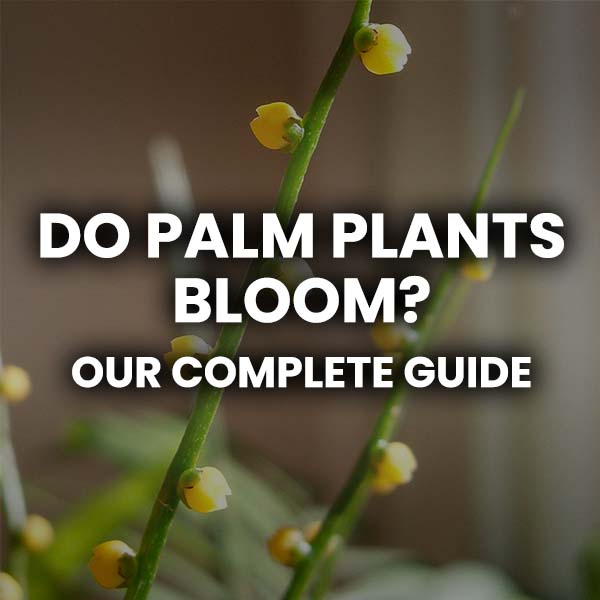
Do Palm Plants Bloom? And How to Promote Blooming
Share this with friends
Palm plants, also known as Palm Trees, are a staple for any plant collector, and are usually one of the first plants you'll see around. They are known for their stunning looks while also being easy to care for.
From the small, delicate flowers of the Parlor Palm and Royal Palm, we will explore the diversity and beauty of these iconic trees.

Whether you are a palm tree collector or simply looking to add some flair to your indoor garden, this post will give you a better understanding of the different types of palm trees and their blooming habits.
So, let's dive in and discover the world of palm trees!
Palm Plant Information
Did you know that there are over 2,600 different species of palm trees? Each one has its own unique characteristics, including the time of year it blooms and the type of flowers it produces.
Palm trees are a popular addition to many indoor gardens, but a question that often arises is whether or not they typically bloom. The answer to this question is a bit more complex than a simple yes or no.
What is the blooming period for Palm Trees?
Most palm trees do bloom, but the timing and frequency of blooming can vary greatly depending on the species and the growing conditions. Some palm species, such as the Coconut Palm and the Date Palm bloom regularly and produce fruit every year.
Other species, such as the Queen Palm and the King Palm may only bloom once in their lifetime and then die.
One of the main factors that can affect a palm tree's ability to bloom is the species. Different species have different blooming habits and may require specific conditions in order to produce flowers.
For example, the Coconut Palm requires a specific amount of sunlight and warmth in order to bloom and produce fruit, while the Date Palm needs a certain amount of water and fertilizer.
Palm Tree Growing Conditions
The growing conditions in which a palm tree is kept are a significant component that can impact its capacity to generate blooms. A warm, sunny environment is always preferred by palm trees. In order for it to develop sturdy roots, it must also be planted in soil that drains properly.
A palm tree will struggle to produce any blooms at all if it is grown in an area that is too cold or if the soil does not drain well. The palm tree may not have the energy it needs to create flowers if it does not receive adequate water or fertilizer.
Finally, proper care and maintenance is important for encouraging your palm tree to bloom. This includes regular watering, fertilizing, and pruning to promote healthy growth and flowers.
In conclusion, most palm trees do bloom, but the timing and frequency of blooming can vary greatly depending on the species and the growing conditions.
You can encourage your palm tree to bloom and thrive by being aware of its precise requirements and creating the ideal conditions.
Palm Tree Blooming Habits
Because they don't have conventional flowers like most plants, palm trees are unusual. Instead, they produce inflorescences, spikes, or panicles as blooms. The size, shape, and colour of these blooms can vary depending on the type of palm tree.
The timing of blooming for palm trees can vary greatly depending on the species and growing conditions. Some species may bloom only once in their lifetime, while others may bloom annually. Some palm species only bloom for a short time, while other species can bloom for several weeks.
There are a few different types of blooms on palm trees
Inflorescences
Inflorescences are the most common type of flower/bloom that you'll find on a palm tree. They form in clusters of small flowers that can be found at the top of the palm tree.
They are usually green or yellow in colour and can be quite fragrant.
Spikes
Another type of bloom that grows on palm trees are spikes.
The trunk or branches of palm palms frequently support these long, slender flower clusters.
They are usually green or yellow in colour and can also be fragrant.
Panicles
Panicles are the last type of bloom found on palm trees. These are large clusters of small flowers that can be found at the top of the palm tree.
They are usually green or yellow in colour and can be quite fragrant.
The blooming process of palm trees
Many factors can influence palm tree flowering, including the species, growing conditions, and the care you provide. Some palm tree species demand specific temperatures or lighting.
Furthermore, if palm trees are not properly cared for, such as with appropriate water or fertilization, they may not flower at all.
How to Make Palm Trees Bloom
Palm trees are a unique type of plant that have unique blooming habits. While not all palm trees bloom, those that do have specific growing conditions that need to be met in order for blooming to occur.
The most important factor of all for a palm tree to bloom is proper light. Most palm trees require full sun exposure in order to bloom. Additionally, palm trees require a consistent supply of water in order to produce blooms. During hot or dry weather they will use more water, so keep your eye on the soil.
Fertilizer is also important ingredient that promotes blooming. A balanced fertilizer should be applied to the soil around the base of the tree, making sure to not over-fertilize.
Proper pruning and shaping of the plant will also play a role in promoting blooms. If a palm tree is overgrown, it may not have enough energy to produce blooms because the energy is spread throughout the leaves and stems.
By trimming and shaping your palm tree it will direct more energy to blooming.
In summary, not all palm trees bloom, and those that do have specific growing conditions that need to be met. Proper light, water, and fertilizer, pruning and shaping and maintaining a healthy environment for the palm tree are all necessary for promoting blooming. With the right care, a beautiful display of blooms can be enjoyed from these unique and majestic trees.
Conclusion
In conclusion, palm trees are a lovely addition to any plant collection. Understanding their blooming habits, growing conditions, and upkeep, will help influence your palm tree's ability to bloom.
To promote blooming, it's important we provide the best growing conditions for a palm tree, such as proper light, water, and fertilizer. Pruning and shaping your palm tree can also help to promote blooming. Additionally, maintaining a healthy environment for your palm tree by avoiding pests, disease, and providing appropriate care is crucial.
If you're interested in learning more about palm tree blooming and care, there are plenty of resources available. Books, websites, and gardening forums are all great places to start. Additionally, consulting with a local nursery or landscaping professional can provide you with expert advice and guidance. Remember, with the right care, your palm tree can bloom and thrive for years to come.





